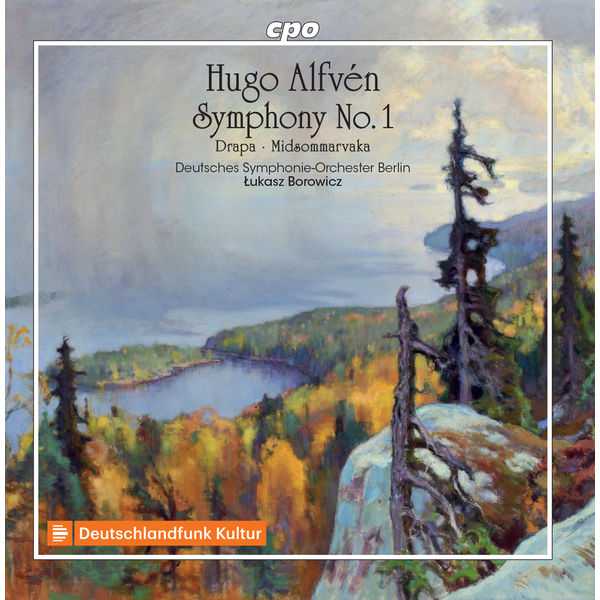
Composer: Hugo Alfvén
Orchestra: Deutsches Symphonie-Orchester Berlin
Conductor: Łukasz Borowicz
Format: FLAC (tracks)
Label: CPO
Catalogue: 5550432
Release: 2018
Size: 291 MB
Recovery: +3%
Scan: yes
Symphony No. 1 in F minor, Op. 7
01. I. Grave. Allegro con brio
02. II. Andante
03. III. Allegro molto scherzando
04. IV. Allegro ma non troppo
05. Drapa for Large Orchestra
06. Swedish Rhapsody No. 1, Op. 19 ‘Midsommarvaka’
Along with Wilhelm Stenhammar and Wilhelm Peterson-Berger, Hugo Alfven surely ranks as one of the leading composers of Swedish late romanticism. In the country of his birth he was noted for his compositions inspired by Swedish folklore – one of which, Midsommarvaka, his most famous work, is heard on Vol. 1 of this new edition of his complete symphonic works. It is both astonishing and impressive that Alfven, who previously had composed nothing more than a few piano pieces, songs, and chamber works, suddenly came forward in 1897 with a full-length symphony of some forty minutes in length. This highly regarded Symphony No. 1 exhibits very finely nuanced tone colours, and with it he immediately became known as a capable and experienced composer. Alfven composed Drapa, a monumental, magnificent, and festive work with the subtitle ‘King Oscar II in memoriam’, for a gala event at the Royal College of Music and conducted its premiere on 18 October 1908. For this ambitious project CPO have secured the support of the German Symphony Orchestra of Berlin and Lukasz Borowicz – one of Germany’s best orchestras and one of today’s most promising young conductors.
Swedish composers, eh? Hmm… Berwald, of course… and then… hmmm. But we mustn’t forget Hugo Alfvén, born in 1872, four years after the death of his illustrious predecessor Berwald, and died in 1960 – six years after the Marteau sans maître! Across around 300 works, not forgetting his many famous aquarelles, he left a lasting mark on the cultural life of his country, and in other spheres as well, such as film music, orchestral conducting, and in musicological writing of all kinds. In his first years as a composer, he focussed on writing a few handfuls of works for piano and chamber music, and, suddenly in 1896, he embarked upon writing a monumental symphony lasting forty minutes, which he finished in 1897. Don’t forget that this was written when Brahms and Tchaikovsky had recently passed away; and yet, considering that it is the work of a young man of 24, a lowly second violinist in the Swedish Royal Orchestra, the maturity of Alfvén’s work, the architecture and the orchestration, are stunning. In it, we hear many Nordic turns of phrase – surely Swedish – and few direct influences from his glorious predecessors: no pseudo-Brahms, no neo-Tchaikovsky, although perhaps one might see Dvořák or some French writers in the clarity of the writing. In short: this is a stupefying act of furious creation, which opened Alfvén’s path to a fine career. More Swedish still, the First Swedish Rhapsody of 1904 brings a strong dose of humour to bear on folk music themes. The result is a delicious concoction which would have done Chabrier proud. The very different Drapa from 1908 is an artefact of a ceremony at the Royal Academy of Music in Stockholm. In it, we hear a harp cadenza of such dimensions that it’s almost a mini-concerto, although the overall atmosphere puts one in mind of composer who had just discovered Elgar’s Pomp and Circumstance.